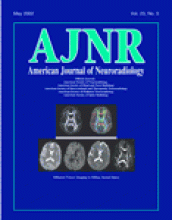Abstract
BACKGROUND AND PURPOSE: Several studies have shown that procedural outcomes are better at high-volume institutions, possibly due to greater physician experience (learning) or practice (repetition). Our purpose was to determine whether outcomes for coil embolization improved with the experience of the practitioner, after adjusting for the perceived risk of treatment.
METHODS: We identified all unruptured aneurysms treated with coil embolization at our institution from 1990 through 1997. A clinical nurse specialist abstracted the characteristics from cases that met the entry criteria. Two neurologists independently determined the complications by using definitions established a priori. The influence of experience of the treating-physician on complications was evaluated with univariate and multivariable logistic regression analyses.
RESULTS: Sixteen complications occurred in 94 patients (17%) treated with coil embolization. Complications occurred in 53% of the first five cases that each of three physicians treated, and in 10% of later cases (P < .001). After an adjustment for all other predictors, including physician assessment of the risk of the procedure, the odds of a complication decreased with increasing physician experience (odds ratio, 0.69 for every five cases treated; 95% confidence interval: 0.50, 0.96; P=.03).
CONCLUSION: The risk of complications with coil embolization of unruptured aneurysms appears to decrease dramatically with physician experience. Because the physicians in this study were highly experienced in other endovascular techniques at study onset, the rate of learning may not be generalizable to other centers.
- Copyright © American Society of Neuroradiology












